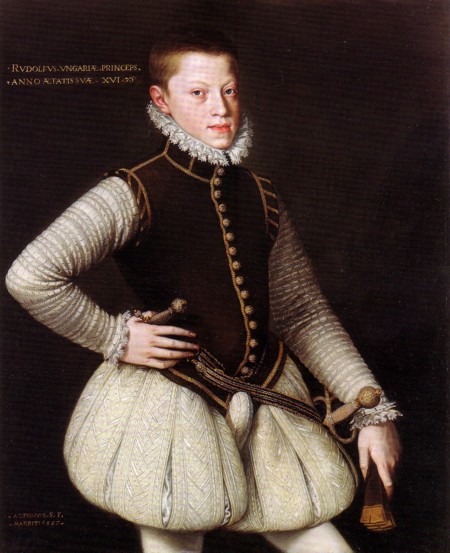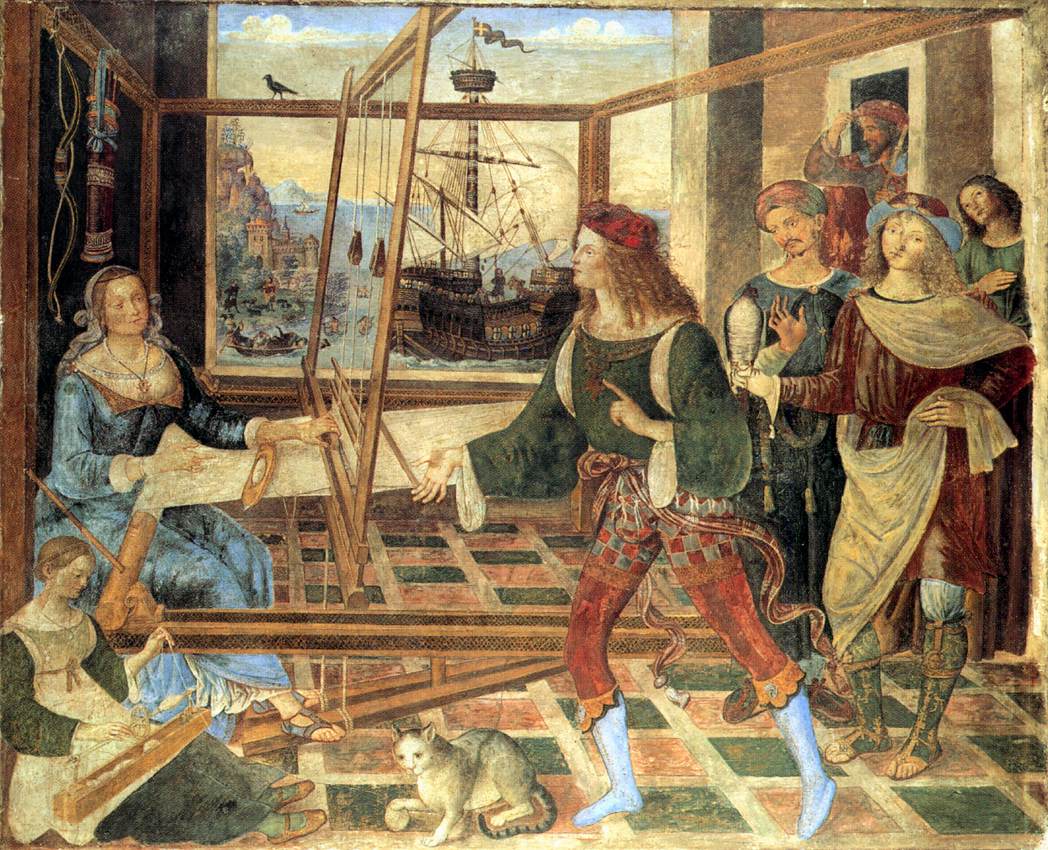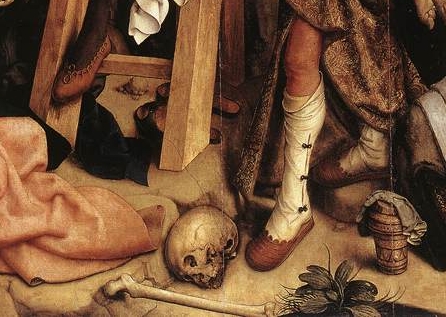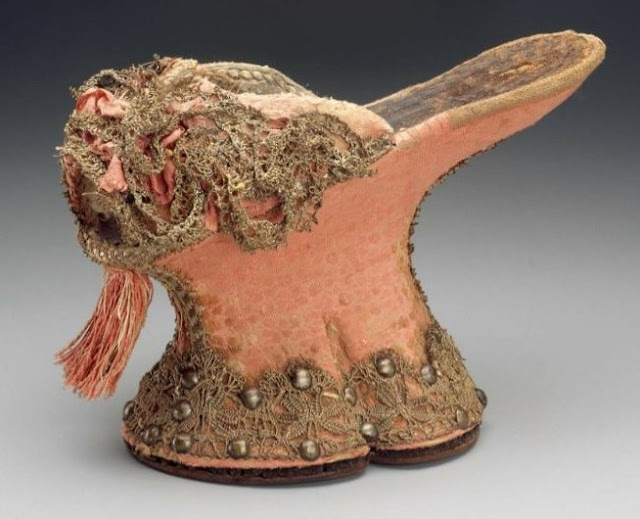
Из истории штанов. Гульфики. 14-15-16 век.
 marinni — 21.09.2010
— История
marinni — 21.09.2010
— История
Гульфики. 14-15-16 век. Часть 1
.jpg)


Давно обещала сделать пост по истории костюма для своих читателей- мужчин. Мужской костюм был порой интересней и роскошней, чем женский, в отличие от сегодняшнего времени.
================Немного из истории штанов================
Короткие штаны 14-15 веков:

Tacuina sanitatis (XIV century)
Detail of men fencing or dueling.

Tacuina sanitatis (XIV century) Detail of shirt and braies, later 15th century.
В 14-15-16 веках наиболее распространенной одеждой мужчин был длинный или короткий дублет.
А внизу, на ногах- носили отдельные чулки в отверстием в верхней части.
--------------------Италия---------------

GIORGIONE
Madonna with the Child, St Anthony of Padua and St Roch
-------------------------------------

Detail from Francesco del Cossa, Triumph of May, Ferrara, about 1470. Particolored hose.

Enea Piccolomini Leaves for the Council of Basle (detail)
1502-08
Fresco
Piccolomini Library, Duomo, Siena
Около середины 1400-х появляется
гульфик, ("codpiece" по английски, "braguette" на французском языке),- лоскут или мешочек из ткани, чтобы скрыть гениталии из поля зрения.

пара середины 14 века
A pair of trousers from the Thorsberg Bog in Schleswig-Holstein, Germany, approx. mid 14th century.
--------------------Гульфики---------------------
======================================================

Гульфик оставался плоским куском ткани в течение ряда лет
потом ему стали придавать форму, он держался на завязках:
--------------


1.гульфик "Болонья"
2.Egg-shaped или яйцевидные
====================================================
------------------ Северная Европа--------------------

================BRUEGEL, Pieter the Elder==================

BRUEGEL, Pieter the Elder
Wedding Dance in the Open Air (detail)
1566
Oil on panel
Institute of Arts, Detroit

BRUEGEL, Pieter the Elder
Wedding Dance in the Open Air (detail)
1566
Oil on panel
Institute of Arts, Detroit

BRUEGEL, Pieter the Elder
The Parable of the Blind Leading the Blind (detail)
1568
Tempera on canvas
Museo Nazionale di Capodimonte, Naples

BRUEGEL, Pieter the Elder
The Parable of the Blind Leading the Blind (detail)
1568
Tempera on canvas
Museo Nazionale di Capodimonte, Naples

carnival
====================Pieter Brueghel the Elder==================
Pieter Brueghel the Elder
Painted c. 1567
--------------------

Schlaraffenland

BRUEGEL, Pieter the Elder
The Land of Cockaigne (detail)
1567
Oil on panel
Alte Pinakothek, Munich

BRUEGEL, Pieter the Elder
The Peasant and the Birdnester
1568
Oil on panel, 59 x 68 cm
Kunsthistorisches Museum, Vienna
=====================ИТАЛИЯ=========================
-------------------------------------------------------

Vittore Carpaccio
The Miracle of the Relic of the Holy Cross, detail
Year 1494
---------------------Pintoricchio--------------
================================================

Pintoricchio
Freskenzyklus zu Leben und Taten des Enea Silvio Piccolomini, Papst Pius II. in der Dombibliothek zu Siena, Szene: Krönung Piccolominis durch Friedrich III. zum Dichter, Detail: zwei Pagen
Date
1502-1507

The Canonization of Catherine of Siena by Pope Pius II (detail)
1502-08
"Pope Aeneas Piccolomini Canonizes Catherine of Siena (detail)

Frederick III Crowning Enea Silvio Piccolomini with a Laurel Wreath
1502-08
Fresco
Piccolomini Library, Duomo, Siena

PINTURICCHIO
The Return of Odysseus
1509
Fresco, transferred to canvas, 124 x 146 cm
National Gallery, London

PINTURICCHIO
The Adoration of the Shepherds (detail)
1501
Fresco
Collegiata di Santa Maria Maggiore, Spello
------------------------Giorgione---------------------
=======================================================

GIORGIONE
Moses Undergoing Trial by Fire
c. 1505
Oil on wood, 89 x 72 cm
Galleria degli Uffizi, Florence

Giorgione

GIORGIONE
The Judgment of Solomon
c. 1505
Oil on wood, 89 x 72 cm
Galleria degli Uffizi, Florence

Fresken der »Wunder des Hl. Antonius von Padua«, Szene: Das Wunder des sprechenden Neugeborenen, der seine Mutter vom bezichtigten Ehebruch freispricht
Date
1511
===============================================
Хотя гульфик был первоначально создан для прикрытия гениталий, он постепенно превратился в модную деталь.
В начале 1500, гульфик вырос в размерах, стал больше и декоративнее, зрительно увеличивая размер половых органов. Впервые в западной моде мужские половые органы были так подчеркнуты и красовались у всех на виду Хотя длина некоторых дублетов скрывала верх бедер, большинство из них имели разрез в передних полах -специальное для гульфика.
Конечно, все это было оскорблением церкви, считающей, что тело и плотские удовольствия- греховны.
Священники и другие священнослужители были в ужасе от новой моды, осуждали и резко выступали против нее.
===================================================

Tiziano Vecellio (Titian)
Federigo Gonzaga, Duke of Mantua 1525-30
--------------------------------------------------
Некоторые гульфики были направленными вверх, напоминая эрегированный пенис. Для поддержания такой "стоячей" формы ткань дублировалась и прокладывалась, чаще всего в несколько слоёв.
Модники увеличивали гульфики до огромных размеров и украшали их всячески- вышивкой, лентами, драгоценными камнями.
Некоторые даже использовали их в качестве своего рода кармана, пряча там мелкие ценные вещи и деньги. Гульфик теперь подчеркивал, а не скрывал мужские достоинства- достигнув своего пика по размерам и декору в 1540-е, прежде чем выйти из моды в 1590-е.
===================Giovanni Battista Moroni==================
--------------------------------------------------------------


Giovanni Battista Moroni
Portrait of Antonio Navagero 1565 Oil on canvas, 115 x 90 cm Pinacoteca di Brera, Milan
Date
1565

Portrait of a Soldier Oil on canvas, 119 x 91 cm Museo del Prado, Madrid
Date
1550

Giovanni Battista Moroni – Tailor
c 1565-70
Oil on canvas


Portrait of Prospero Alessandri (1560). Oil on canvas, height 105 cm, width 84 cm, Liechtenstein Museum, Vienna.
Date
1580


Venetian Province of Bergamo, The Republic of Venic
Giovanni Battista Moroni, 1560: The Gentleman in Pink (Detail)
Bergamo, Palazzo Moroni
----------------------Италия-------------------

Moretto da Brescia, 1526: Portrait of a Man
London, National Gallery

Venetian province of Brescia, The Republic of Venice
Bartolomeo Veneto, c1546: Portrait of Lodovico Martinengo
London, National Gallery

Ritratto di Alessandro Farnese giovinetto
Antonio Mor (1520 - 1576/77)
Parma, Galleria Nazionale
======================Испания=============================
-----------------------------------------------------------

Maria of Spain and Emperor Maximillian II, grandchildren of Juana of Castile, great-niece and nephew of Catherine of Aragon,and their children
===================Филипп II===============
-----------------------------------

Portrait of Philip II
c. 1554
Oil on canvas, 185 x 103 cm
Galleria Palatina (Palazzo Pitti), Florence

TIZIANO Vecellio
Portrait of Philip II in Armour
1550-51
Oil on canvas, 193 x 111 cm
Museo del Prado, Madrid
-------------------Испания--------------
============================================

Сын Филиппа II
Alonso Sanchez Coello
Painting Title: Portrait of Don Carlos 1545-68, son of Philip II of Spain, after Sofonisba Anguissola c.1527-1626

Don Carlos (1545-68), Son of King Philip II of Spain (1556-98) and Maria of Portugal, 1564
by Alonso Sanchez Coello
=============================================

Count of Hoorn
Philip_de_Montmorency
Image engraved by en:Simon de Passe

Georg Pencz
Портрет молодого человека.
Portrait of a Seated Youth 1544
----------------------------------------

Erzherzog Ferdinand II. (1529-1595), Kniestück
Date
Deutsch: nach 1557

Erik XIV of Sweden by Steven van der Meulen 1561

Kaiser Karl V. (1500-1558) mit seinem Englischen Wasserhund
Date
1532
Но, несмотря на все увещевания церкви- мода дошла до того, что такие гульфики стали делать подросткам и даже маленьким детям!
=======================Дети======================
Boston, Museum of Fine Arts

Длинные дублеты часто закрывали штаны.
Venice, The Republic of Venice
Paolo Veronese, c1551-52: Iseppo and Adriano da Porto
Paris, Musée du Louvre

Venetian Province of Bergamo, The Republic of Venice
Giovanni Battista Moroni, c1545-50: Count Alborghetti of Bergamo and his son

Venice, The Republic of Venice
Giovanni Antonio Fasolo, c1560: Giuseppe Gualdo And Sons
Vicenza, Museo Civico
---------------------------------------

Servant_walking_two_boys
Amman, Jost (1539 Zurich -1591 Nuremburg): Servant walking two boys in the city of Nuremburg. Woodcut, Holzschnitt, B.234.
-----------------------

COLECCION RETRATO DEL INFANTE DON FERNANDO - 1577 - 120X110 CM -O/L Obra de SANCHEZ COELLO ALONSO 1531/88

Alonso Sanchez Coello
Painting Title: Prince Don Carlos of Austria
Museum: Museo del Prado, Madrid, Spain

Portrait of Ranuccio Farnese 1542
Tiziano Vecellio (Titian)
=====================Австрия======================
------------------Rudolf II---

Archduke Rudolf, the later Holy Roman Emperor Rudolf II. of Austria, son of Holy Roman Emperor Maximilian II. of Austria and Infanta Maria of Spain, 1567 He is wearing pumpkin hose (pluderhose) with a codpiece
----------------------Франция-----------
============================================

Studio of François Clouet
Description
Henri II Roi de France

Henri II de France
Date
16th century
Henri II de France

king_charles_ix_france_1550
--------------------------Англия------------------------
=========================Генрих VIII==========================
---------------------------------------------------------------
В английском, "a cod " (или " в старом английском, "Coddd" означает "мешок" или "мошонка",а не рыбу, в связи с этим было много острот и непристойностей по поводу блюд из рыбы.

Henry VIII: ca 1545

По легенде-во время посещения Англии, герцог Фабрицио Болоньи поразил короля Генриха VIII и королеву Анну Болейн размером и конструкцией своего гульфика.
Королю Генриху VIII понравилась эта деталь, и он перенял ее для себя: "He immediately ordered his codpieces padded in order that he not look out of date by comparison to Duke Fabrizio, commanding, "My codpieces must compare favorably to Bologna."

Detail of The Family of Henry VIII, now at Hampton Court Palace, c. 1545 Oil on canvas, 141 x 355 cm Left to Right: Prince Edward, Henry VIII, Jane Seymour
Date
c 1545

Он принимает делегацию цирюльников-хируров и создается их официальная гильдия
Henry VIII and the Barber Surgeons
-------------------Англия---------------

Robert Dudley, Earl of Leicester, c. 1564, oil on panel

Robert Dudley, Earl of Leicester. Oil on panel. 110 x 80 cm. At Waddesdon, The Rothschild Collection.
c. 1564

Henry Howard Earl of Surrey at age 29, 1546
Date
1546(1546)
Source
Scanned from Hearn, Karen, ed. Dynasties: Painting in Tudor and Jacobean England 1530-1630

Sir Philip Sidney, by unknown artist, given to the National Portrait Gallery, London
c.1576.
Гульфик, действительно, становятся все меньше к середине 1500, возможно потому, что новым правителем Англии стала королева Елизавета I (1533-1603), и ей не нужен был этот пример мужского тщеславия. В 1575-х -90-х гульфик постепенно исчез и и был заменен вертикальной щелью, скрытой в складках штанов.
Ну а во Франции король Генрих III был гомосексуалистом и очень сильно феминизировал мужскую моду.

English: Portrait of Jacopo Foscarini, 1575, oil on canvas, 105 x 83,5 cm, Museum of Fine Arts, Budapest
Español: Retrato de Jacopo Foscarini, 1575, óleo sobre lienzo, 105 x 83,5 cm, Museo de Bellas Artes de Budapest
Date
1575

---------------------------------------------------------------

Sir Walter Raleigh in paned trunk hose and cannions, and his son in loose slops, 1602.
С женщиной на английском престоле и гомосексуалистом на французском - не было ничего удивительного, что гульфик исчез полностью.
===============Еще гульфики:=====================

Гульфик с бантами и лентами или
Be-ribboned or
"foofy" codpiece

"колбаска"- стальной гульфик
Armored or
"sausage o' steel"
codpiece
===================Латы-гульфики=====================

================"поднятая" форма==================

braguette, codpiece, kulzak of kullezak
Солдаты, ландскнехты и гульфики с латами и на латах- в следующем посте.
Пишите, что вам еще интересно из мужского костюма, я постараюсь выложить.
======================================
Еще по теме:



Женские и мужские шлепанцы (chopines) на платформе и прочие тапочки.15-17 век-ТУТ



Женская обувь 15-16 века и "Сhopines" на платформе-ТУТ


Мужской костюм, прически и мужчины-модники 18 века-ТУТ


Мода и модники конца 18-начала 19 века-ТУТ
========================================================
In the 14th century, men's hose were two separate legs worn over linen drawers, leaving a man's genitals covered only by a layer of linen. As the century wore on and men's hemlines rose, the hose became longer and joined at the centre back but remained open at the centre front.
The hosiery of the time consisted of two separate stockings that covered the legs but left an opening at the top that exposed the wearer's genitals.
To preserve modesty and protect the genitals, medieval tailors invented the codpiece around the mid-1400s.The codpiece, called a braguette in French, was a flap or pouch of fabric sewn at the top of a man's hose to hide his genitals from view.
While the codpiece was originally created to provide modesty, it evolved into a fashion statement.
By the early 1500s, the codpiece had grown larger and more decorative and had become a way to advertise one's masculinity, by exaggerating the size of his genitals.
Though doublets became long enough to cover the genitals, most had a special opening in the front for the codpiece to stick through in a visible way.
Some codpieces were even designed to curve upward to resemble an erect penis. Fashionable men, led by England's King Henry VIII (1491–1547), padded their codpieces to enormous sizes and decorated them with jewels.
Some even used them as a sort of pocket, hiding small weapons or valuables there.
Priests and other clergy were horrified by the new style and spoke out against it.
. While visiting England, Duke Fabrizio of Bologna, dressing hastily after a quick romantic interlude, used the flap to contain (or perhaps restrain) his nether parts while appearing before King Henry VIII and Queen Anne Boleyn. Anne Boleyn Queen Anne, amused at the Italian's conspicuous bulge, remarked "Be that thine codling or art thou glad to see me?"
Those tailors, very literal-minded fellows all, envisioned pork sausages and thus began the whole size contest that continues to this day. So....what exactly is a Codpiece? The codpiece, emerged (no pun intended!) in the fifteenth and sixteenth centuries from the dilemma of how to cover a man's genitals when the jackets or doublets became shorter
The result was that the male bulge was to be the center of attention for the next 200 years. Of course, all of this was an affront to the Church that considered that the body was sinful and should be covered. When the Black Death hit Europe in 1347, the Church was quick to declare that this was, in fact, divine punishment for the sinful clothes men were wearing. However, terrible that the Plague was, it did not put a stop to the fashion and afterward coats continued to grow shorter and things became ever more fanciful. From the 1420s-1440s, the hemlines of tunics reached the top of the thigh, and the occasional glimpse of the male sexual organs that had caused such an outcry in the fourteenth century, was now replaced by permanent exposure of that zone.
Whereas Henry's reign provided fashions that merely exaggerated what was normal, Elizabeth's reign sparked fashions that had the most unnatural of silhouettes. With a woman on the throne, it would seem logical that the codpiece would fall from use, or disappear altogether."The codpiece continued in fashion until about 1575, becoming smaller with less bombast from about the 1540's. It was finally discarded at the end of the century, and was replaced by a vertical slit in front which was concealed in folds of material." (11) Queen Elizabeth never married, and by 1575 it is likely that she had given up hope of conceiving children, even if she did choose to marry, as she was already well into her forties by that time.
The codpiece did indeed get smaller by the mid-1500s, possibly because Queen Elizabeth I (1533–1603) was the new ruler of England and did not appreciate this example of male vanity. By 1575 the codpiece had disappeared, replaced by short padded breeches, or pants, which provided coverage.
While Elizabeth I had a great influence on women's fashion during her reign, it was Henri III, king of France, who had an impact on men's fashion.That Henri III was a homosexual may or may not have influenced his ruling of France, but it had a marked effect on men's fashions.
With a woman on the English throne and a homosexual man on the French throne, it would not be surprising that the codpiece disappeared entirely.
=====================================
http://www.fashionencyclopedia.com/fashion_costume_culture/European-Culture-16th-Century/Codpiece.html
http://www.theweebsite.com/sewing/codpiece.html
http://en.wikipedia.org/wiki/Codpiece
http://www.users.qwest.net/~rappleyard/codpiece/definition/index.html
http://commons.wikimedia.org/wiki/Category:Trousers
http://commons.wikimedia.org/wiki/Category:Codpieces
===========================================
http://www.thehendricks.net/codpiece_history.htm
http://www.artst.org/high-renaissance/
http://www.tudorplace.com.ar/
http://www.google.ru/images?hl=ru&newwindow=1&client=firefox&rls=org.mozilla:ru:official&q=http://www.tudorplace.org&um=1&ie=UTF-8&source=og&sa=N&tab=wi&biw=1592&bih=833
http://realmofvenus.renaissanceitaly.net/wardrobe/men/VenMenGall3b.htm
http://www.tudorplace.com
------------------------------------------
http://www.luminarium.org/renlit/ralegadd.htm
----------------------------------
http://www.artst.org/high-renaissance/
http://www.titian-tizianovecellio.org/the-complete-works-4-48-3-0.html
http://www.google.ru/images?um=1&hl=ru&newwindow=1&client=firefox&rls=org.mozilla:ru:official&biw=1592&bih=833&tbs=isch:1&btnG=%D0%9F%D0%BE%D0%B8%D1%81%D0%BA&aq=f&aqi=&oq=&gs_rfai=&q=Philip%20II%20ofSpain
http://www.google.ru/images?q=Alonso+Sanchez+Coello&oe=utf-8&rls=org.mozilla:ru:official&client=firefox&um=1&ie=UTF-8&source=og&sa=N&hl=ru&tab=wi&biw=1592&bih=833
http://www.google.ru/images?q=Giovanni+Battista+Moroni&oe=utf-8&rls=org.mozilla:ru:official&client=firefox&um=1&ie=UTF-8&source=og&sa=N&hl=ru&tab=wi&biw=1592&bih=833

 Современные технологии очистки воды: какой метод выбрать для вашего дома
Современные технологии очистки воды: какой метод выбрать для вашего дома  Две новости из Израиля
Две новости из Израиля  Акварели
Акварели  Тамара Лемпицка жила в «ревущие двадцатые»
Тамара Лемпицка жила в «ревущие двадцатые»  Живопись... художник Аугусто Пейщёто.
Живопись... художник Аугусто Пейщёто.  USAID
USAID 



